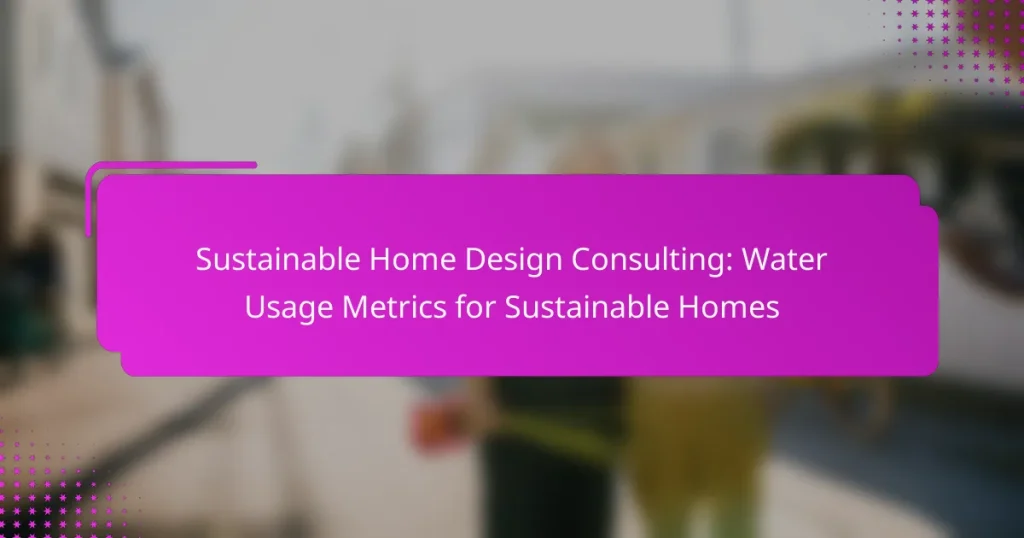Sustainable home design consulting emphasizes the importance of water usage metrics to minimize consumption and enhance efficiency. By incorporating water-efficient fixtures, rainwater harvesting, and greywater recycling, homeowners can significantly reduce their water footprint while promoting sustainable living practices.

What are the best practices for water usage metrics in sustainable home design?
Best practices for water usage metrics in sustainable home design focus on minimizing consumption while maximizing efficiency. Implementing strategies such as water-efficient fixtures, rainwater harvesting, and greywater recycling can significantly reduce a home’s water footprint.
Water-efficient fixtures
Water-efficient fixtures, including low-flow faucets, showerheads, and toilets, are essential for reducing water usage in homes. These fixtures can use up to 30% less water than standard models, helping to conserve resources without sacrificing performance.
When selecting water-efficient fixtures, look for products that meet the WaterSense label, which indicates they meet strict efficiency criteria. Regular maintenance is also crucial to ensure these fixtures continue to operate effectively and efficiently.
Rainwater harvesting systems
Rainwater harvesting systems collect and store rainwater for non-potable uses, such as irrigation and toilet flushing. These systems can reduce reliance on municipal water supplies and lower water bills, especially in areas with high rainfall.
To implement a rainwater harvesting system, consider the size of your roof, local regulations, and the intended use of the collected water. A well-designed system can capture thousands of liters annually, depending on rainfall patterns.
Greywater recycling
Greywater recycling systems reuse water from sinks, showers, and washing machines for irrigation and other non-potable applications. This practice can save a significant amount of water, as greywater makes up about 50-80% of residential wastewater.
Before installing a greywater system, check local regulations, as some areas have specific guidelines for greywater use. Proper filtration and treatment are necessary to ensure safety and prevent contamination.
Smart irrigation technologies
Smart irrigation technologies optimize water use in landscaping by adjusting watering schedules based on weather conditions and soil moisture levels. These systems can reduce water waste by up to 50% compared to traditional irrigation methods.
Consider installing soil moisture sensors and weather-based controllers to enhance your irrigation system. Regularly monitor and adjust settings to ensure efficient water usage throughout the growing season.
Low-flow appliances
Low-flow appliances, such as dishwashers and washing machines, are designed to use less water while maintaining cleaning performance. These appliances can save households hundreds of gallons of water each year, making them a smart choice for sustainable living.
When purchasing low-flow appliances, look for the ENERGY STAR label, which indicates energy efficiency and water conservation. Be sure to compare models to find the best balance of efficiency and performance for your needs.
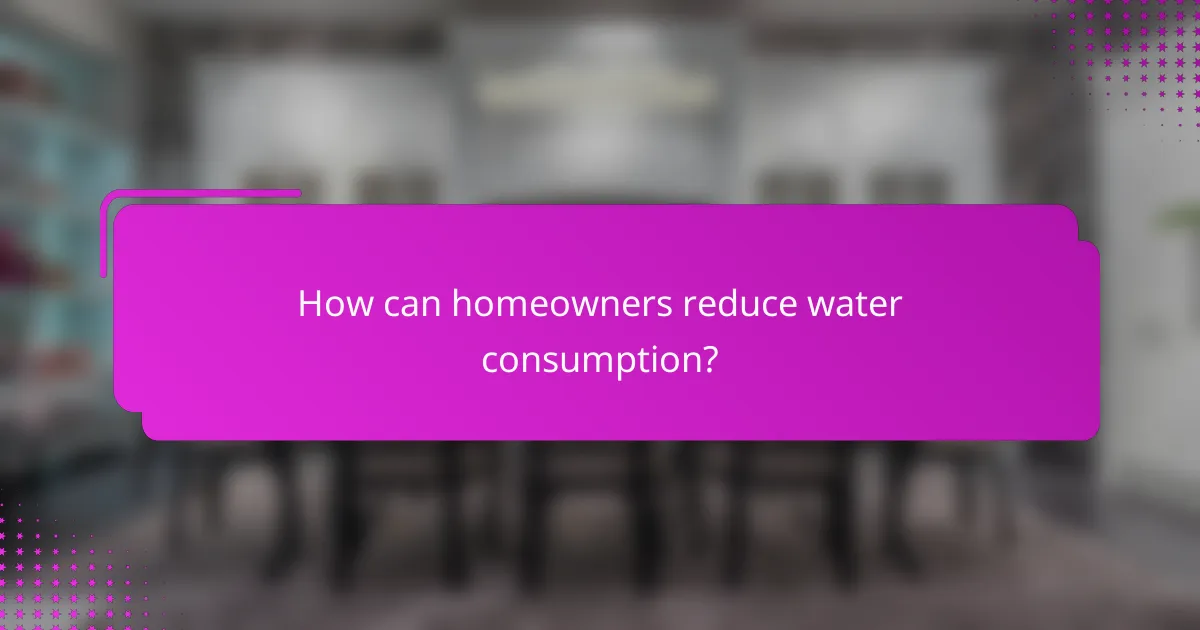
How can homeowners reduce water consumption?
Homeowners can significantly reduce water consumption by implementing efficient landscaping, maintaining plumbing systems, and selecting appropriate plant species. These strategies not only conserve water but also promote sustainable living practices.
Implementing xeriscaping
Xeriscaping is a landscaping method that minimizes water use by incorporating drought-resistant plants and efficient irrigation techniques. This approach is particularly beneficial in arid regions, where water scarcity is a concern.
To implement xeriscaping, homeowners should assess their local climate and soil conditions, then choose native or drought-tolerant plants that thrive with minimal irrigation. Grouping plants with similar water needs can further enhance efficiency.
Using drought-resistant plants
Drought-resistant plants are specifically adapted to survive with limited water, making them ideal for sustainable home gardens. Examples include succulents, lavender, and ornamental grasses, which require less frequent watering compared to traditional garden plants.
When selecting drought-resistant plants, consider local varieties that are well-suited to your climate. This not only reduces water consumption but also supports local ecosystems and biodiversity.
Regular plumbing maintenance
Regular plumbing maintenance is essential for reducing water waste in homes. Leaky faucets, toilets, and pipes can lead to significant water loss, often unnoticed until it becomes a larger issue.
Homeowners should routinely check for leaks and schedule professional inspections at least once a year. Simple fixes, such as replacing worn washers or seals, can prevent excessive water usage and save on utility bills.
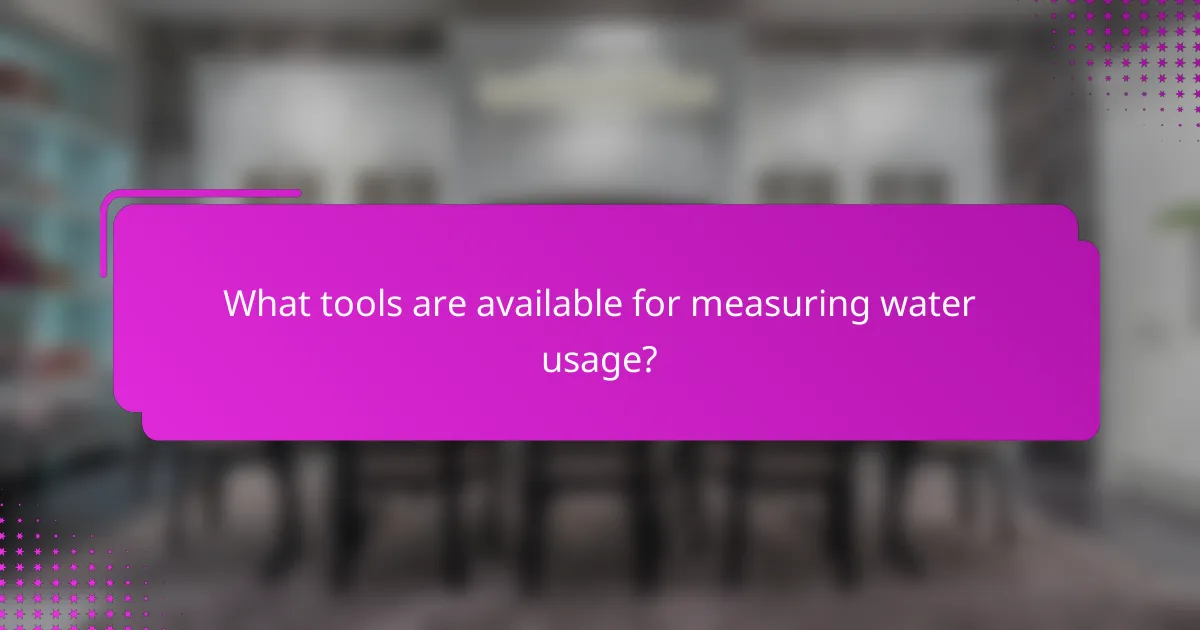
What tools are available for measuring water usage?
Several tools can effectively measure water usage in sustainable homes, helping homeowners monitor and manage their consumption. These tools include water flow meters, smart home water monitors, and leak detection systems, each offering unique features and benefits.
Water flow meters
Water flow meters measure the volume of water flowing through pipes, providing real-time data on usage. They can be installed at various points in a plumbing system, allowing homeowners to track consumption for specific appliances or entire households.
When selecting a flow meter, consider factors such as installation complexity, accuracy, and compatibility with existing plumbing. Prices typically range from $50 to several hundred dollars, depending on the model and features.
Smart home water monitors
Smart home water monitors connect to your home’s Wi-Fi network and provide detailed insights into water usage via a smartphone app. They can alert homeowners to unusual patterns, helping to identify wasteful practices or leaks.
These devices often include features like historical usage data, real-time alerts, and integration with other smart home systems. Expect to invest between $100 and $300 for a quality smart water monitor.
Leak detection systems
Leak detection systems use sensors to identify leaks in plumbing and alert homeowners before significant damage occurs. These systems can be standalone devices or integrated into smart home setups, providing peace of mind and potential cost savings on repairs.
When choosing a leak detection system, look for features such as automatic shut-off valves, smartphone notifications, and battery backup. Prices can vary widely, typically ranging from $50 to $500, depending on the system’s capabilities and coverage area.
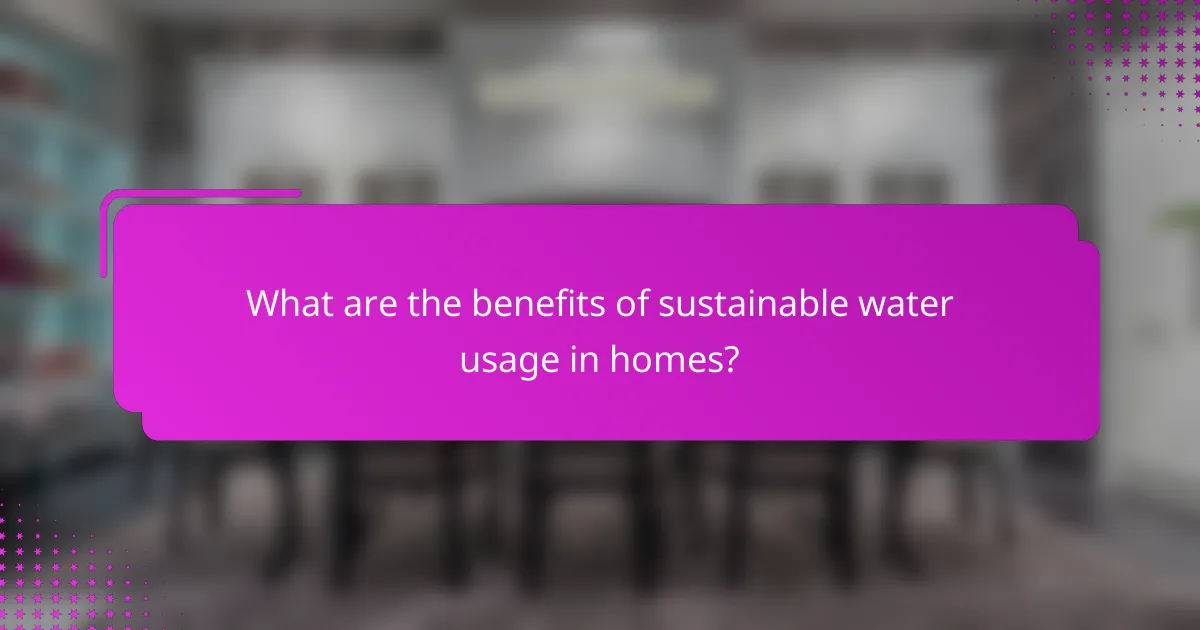
What are the benefits of sustainable water usage in homes?
Sustainable water usage in homes leads to significant cost savings, environmental benefits, and increased property values. By implementing efficient water practices, homeowners can reduce their water bills while contributing to the conservation of local ecosystems.
Lower utility bills
Adopting sustainable water practices can dramatically lower utility bills. Simple measures like installing low-flow fixtures, rainwater harvesting systems, and efficient irrigation can reduce water consumption by 20-50%.
Homeowners should regularly check for leaks and consider using smart irrigation controllers that adjust watering schedules based on weather conditions. These steps not only save money but also enhance the home’s overall efficiency.
Environmental conservation
Efficient water usage plays a crucial role in environmental conservation. By reducing water waste, homeowners help preserve local water sources and minimize the energy required for water treatment and distribution.
Implementing xeriscaping, which involves using drought-resistant plants, can further reduce water needs in landscaping. This practice supports local biodiversity and decreases the ecological footprint of the home.
Increased property value
Homes designed with sustainable water usage in mind often see an increase in property value. Energy-efficient features, including water-saving technologies, are attractive to environmentally conscious buyers.
Investing in sustainable water solutions can yield a return on investment of 5-15% when selling a home. Additionally, properties with lower utility costs are more appealing, making them competitive in the real estate market.

How do local regulations affect water usage in sustainable homes?
Local regulations play a crucial role in determining water usage in sustainable homes by setting standards for efficiency and conservation. These regulations can include specific building codes and water conservation mandates that guide homeowners and builders in their design and operational choices.
Building codes
Building codes are legal requirements that dictate how homes must be constructed, including water usage standards. These codes often specify the types of plumbing fixtures that must be installed, such as low-flow toilets and faucets, which can significantly reduce water consumption.
For example, many jurisdictions require that new homes use fixtures that limit water flow to a certain number of liters per minute. Homeowners should check local building codes to ensure compliance and take advantage of any incentives for exceeding minimum requirements.
Water conservation mandates
Water conservation mandates are regulations designed to promote the efficient use of water resources. These mandates can include restrictions on outdoor watering, requirements for rainwater harvesting systems, and guidelines for landscaping that minimizes water use.
In some areas, homeowners may be required to implement specific water-saving technologies, such as greywater recycling systems. Understanding these mandates is essential for sustainable home design, as they can influence both initial construction costs and long-term water savings.
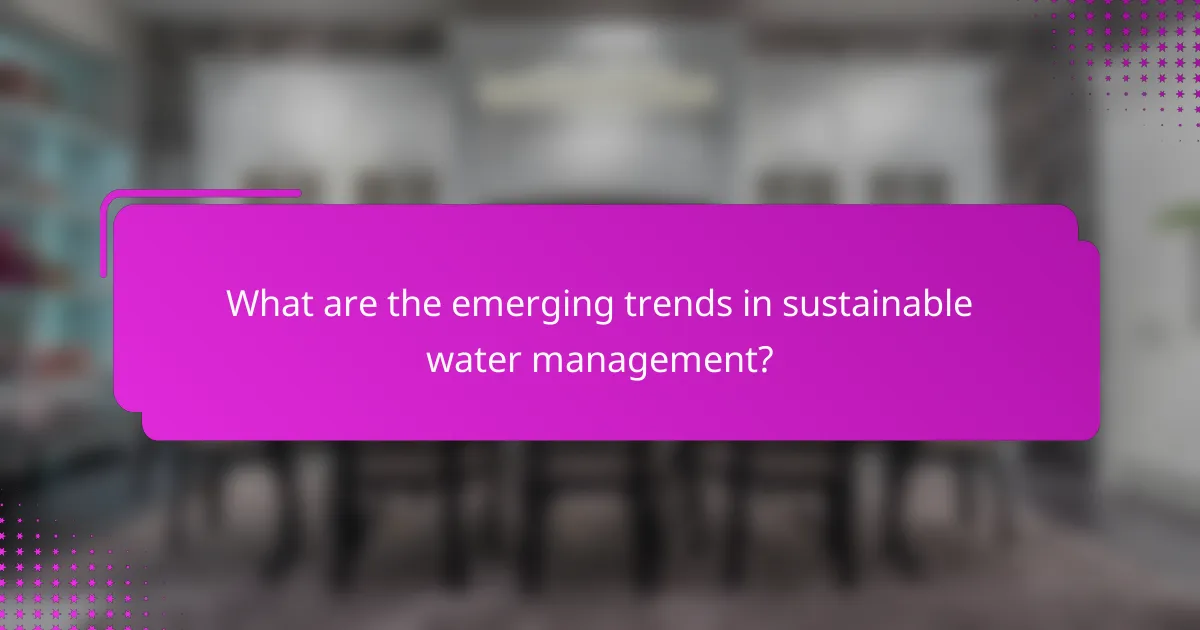
What are the emerging trends in sustainable water management?
Emerging trends in sustainable water management focus on optimizing water usage and minimizing waste through innovative technologies and practices. These trends aim to enhance efficiency, reduce costs, and promote environmental stewardship in residential settings.
Smart water management systems
Smart water management systems utilize advanced technology to monitor and control water usage in homes. These systems often include sensors, automated controls, and data analytics to provide real-time insights into water consumption patterns.
Homeowners can benefit from smart irrigation systems that adjust watering schedules based on weather conditions, reducing unnecessary water use. Additionally, leak detection sensors can alert homeowners to potential issues, preventing costly water damage and waste.
When considering smart water management, look for systems compatible with existing home automation platforms. It’s also wise to evaluate the upfront costs versus long-term savings on water bills, as many systems can pay for themselves over time through reduced consumption.
